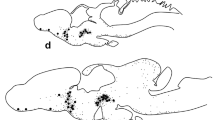Summary
-
1.
The glandular parts of the lamprey pituitary develop from the solid nasohypophyseal stalk.
-
2.
The pro-adenohypophysis consists of only one type of cell; this is basophilic and also PAS-positive, and it probably produces the gonadotropic hormone.
-
3.
In the meso-adenohypophysis, two types of cells are present; the more numerous of these is chromophobic, and possibly produces the somatotropic hormone. The other type is basophilic, stains with aniline-blue, is PAS-positive and can be stained by the chrome-haematoxylinphloxin method of Gomori. These latter cells are only active for a short time before, during and after metamorphosis and probably produce the thyrotropic hormone.
-
4.
The meta-adenohypophysis is highly active during and shortly after metamorphosis, whereas before metamorphosis no activity could be observed in the cells.
It is assumed that these cells are the source of the melanophore-dispersing principle. Their abrupt activity can be related to the fact that the larvae live burrowed in the mud and that metamorphosing animals are free-swimming animals with a clear colour-pattern.
-
4.
Abundant neuro-secretory material is present in the neurohypophysis: this substance disappears during and after metamorphosis. It is highly probable that it contains the water-balance principle.
Similar content being viewed by others
Literature
Beer, G. R. de: The comparative anatomy, histology and development of the pituitary body. London: Oliver & Boyd 1926.
Charipper, H. A.: The morphology of the hypophysis in lower vertebrates, particularly Fish and Amphibia, with some notes on the cytology of the pituitary of Incarassius aumtus (the goldfish) and Necturus maculosus (the mudpuppy). Cold Spr. Harb. Symp. quant. Biol. 5, 151–164 (1937).
Cordier, R.: L' hypophyse de Xenopus; interprétation histophysiologique. Ann. Soc. roy. zool. Belg. 84, 5–16 (1953).
Green, J. D.: The comparative anatomy of the hypophysis, with special reference to its blood supply and innervation. Amer. J. Anat. 88, 225–311 (1951).
Herlant, M.: Anatomie et histophysiologie comparée de l'hypophyse antérieure chez les Mammifères. Ann. Soc. roy. zool. Belg. 82, 463–495 (1951).
—: Anatomie et physiologie comparées de l'hypophyse dans la série des vertébrés. Bull. Soc. zool. France 79, 256–281 (1954).
Knowles, F. G. W.: The influence of anterior-pituitary and testicular hormones on the sexual maturation of lampreys. J. exp. Biol. 16, 535–547 (1939).
—: The duration of larval life in Ammocoetes and an attempt to accelerate metamorphosis by injections of an anterior-pituitary extract. Proc. zool. Soc. Lond. 111, 101–109 (1941).
Lanzing, W. J. R.: The occurrence of a waterbalance-, a melanophore-expanding and an oxytocic principle in the pituitary gland of the river-lamprey (Lampetra fluviatilis L.). Acta endocr. (Kbh.) 16, 277–284 (1954).
Leach, W. J.: The hypophysis of lampreys in relation to the nasal apparatus. J. Morph. 89, 217–255 (1951).
Olivereau, Madeleine, et M. Herlant: Etude histologique de l'hypophyse de Caecobarbus Geertsii Blgr. Bull. Acad. roy. Sci. Belg. 40, 50–57 (1954).
Pickford, Grace E., and J. W. Atz: The physiology of the pituitary gland of fishes. New York: New York Zool. Society 1957.
Purves, H. D., and W. E. Griesbach: The site of thyrotrophin and gonadotrophin production in the rat pituitary studied by McManus-Hotchkiss staining for glycoprotein. Endocrinology 49, 244–264 (1951).
Redeke, H. C.: De visschen van Nederland. Leiden: Sijthoff 1941.
Romeis, B.: Innersekretorische Drüsen II, Hypophyse. In Handbuch der mikroskopischen Anatomie des Menschen, Bd. 6, Teil 3. Berlin-Göttingen — Heidelberg: Springer 1940.
Roth, W. D.: The pars distalis of the adenohypophysis of the sea lamprey Petromyzon marinus. Anat. Rec. 127, 445 (1957).
Stendell, W.: Die Hypophysis cerebri. In Lehrbuch der vergleichenden mikroskopischen Anatomie der Wirbeltiere, Bd. 8. Jena: Gustav Fischer 1914.
Tilney, F.: The hypophysis cerebri in Petromyzon marinus dorsatus Wilder. Bull, neurol. Inst. N. Y. 6, 70–117 (1937).
Young, J. Z.: The photoreceptors of lampreys. II The functions of the pineal complex. J. exp. Biol. 12, 254–270 (1935).
—: The life of Vertebrates. Oxford: Clarendon Press 1950.
Young, J. Z., and C. W. Bellerby: The response of the lamprey to injection of anterior lobe pituitary extract. J. exp. Biol. 12, 246–253 (1935).
Author information
Authors and Affiliations
Additional information
Acknowledgments: The authors wish to express their sincere thanks to Dr. J. M. Dodd for his help in preparing the English text, to Prof. Dr. R. Cordier and Dr. M. Herlant for their valuable remarks, and to Prof. Dr. G. J. Van Oordt and Prof. Dr. Chr. P. Raven, for their suggestions and interest during the work.
Rights and permissions
About this article
Cite this article
van de Kamer, J.C., Schreurs, A.F. The pituitary gland of the brook lamprey (Lampetra planeri) before, during and after metamorphosis (A preliminary, qualitative investigation). Zeitschrift füur Zellforschung 49, 605–630 (1959). https://doi.org/10.1007/BF00338867
Received:
Issue Date:
DOI: https://doi.org/10.1007/BF00338867




